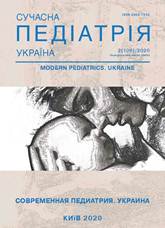Physical and sexual development of girls from armed conflict zone as an indicator of reproductive potential
Keywords:
development, sexual development, children from the zone of armed conflictAbstract
Currently, the problem of maintaining reproductive health is rather acute. Changes in physical and sexual development are those indicators that will allow to identify a high?risk group even at an early stage for formation of reproductive potential disorders. The purpose of the study is to characterize the physical and sexual development of girls from armed conflict zone.
Materials and methods. 158 girls were examined at the age of 7–17 years suffered as a result of armed conflict. Clinical anthropometry was performed to assess physical development (standing height, body weight, body mass index). The main indicators of puberty were the severity of secondary sexual characteristics (development of the mammary gland, pubic and axillary hair growth) and the time of the first menstruation. Menstrual dysfunction was assessed.
Results. It was revealed that more than 40% of girls from the zone of armed conflict have dishormonization of physical development. Significant deviations (<3 and >97 percentiles) on the growth side and 19.0% on the side of body weight were observed in 16.5% of examined girls. The most vulnerable to physical developmental disorders at the time of the armed conflict were girls whose sexual development matched prepubertal and early puberty. It was found that almost a third of all examined girls have deviations in the formation of sexual development, which is 1.5 times more likely than in Kharkov population. 29.4% of 10–13 years old have outstripping rates of sexual development. In 14.1% of adolescents aged 14–17, the lag in the pace and timing of sexual development was recorded. Disorders of menstrual function were detected in every second patient (52.8%). Menstrual irregularities were significantly more often recorded in girls with disharmonious physical development (56.8% vs 42.6%, p<0.001).
Conclusions. The physical and sexual development of children and adolescents is one of the most important indicators of the health of the younger generation and can be used as the main most obvious and highly reliable criteria to identify high-risk groups of reproductive potential disorders.
The research was carried out in accordance with the principles of the Helsinki Declaration. The study protocol was approved by the Local Ethics Committee of an participating institution. The informed consent of the patient was obtained for conducting the studies.
References
Akarachkova ES, Vershinina SV, Kotova OV, Ryabokon IV. (2013). Osnovyi terapii i profilaktiki stressa i ego posledstviy u detey i podrostkov. Voprosyi sovremennoy pediatrii. 12(3): 38–42.
Gureva VA, Danilova IM, Danilova AN. (2008). Reproduktivnoe zdorove devochek8podrostkov v gorode i selskoy mestnosti. Sibirskiy meditsinskiy zhurnal. 2: 71–74.
Korolyuk EG. (2011). Patoautokinez snizheniya urovnya zdorovya rebenka, nahodyaschegosya v usloviyah hronicheskogo sotsialnogo stressa. Vestnik novyih meditsinskih tehnologiy. XVIII (4): 270–272.
Korolyuk EG, Zhukov SV. (2009). Vliyanie hronicheskogo sotsialnogo stressa na uroven zdorovya podrostkov — vyinuzhdennyih pereselentsev. Vestnik novyih meditsinskih tehnologiy. XVI (3): 225–226.
Kulakov VI, Uvarova EV. (2005). Sovremennyie lechebno-diagnosticheskie tehnologii v detskoy ginekologii. Reproduktivnoe zdorove detey i podrostkov. 1: 11–15.
Kuchma VR, Stepanova MI. (2006). Osobennosti sostoyaniya zdorovya sovremennyih shkolnikov. Voprosyi sovremennyie pediatrii. 5 (5): 14–21.
Radzinskiy VE, Hamoshina MB, Lebedeva MG, Arhipova MP et al. (2010). Devushki-podrostki RF: sovremennyie tendentsii formirovaniya reproduktivnogo potentsiala: obzor literaturyi. Sibirskiy meditsinskiy zhurnal. 25(4);2 : 9–14.
Uvarova EV, Kulakov VI. (2005). Sovremennyie problemyi reproduktivnogo zdorovya devochek. Reproduktivnoe zdorove detey i podrostkov. 1: 6–10.
Hamoshina MB, Lebedeva MG, Vahayuova MI, Medvedkina SD, Goncharova OA. (2011). Yuvenilnaya ginekologiya: problemyi i perspektivyi XXI veka. Vestnik reproduktivnogo zdorovya. 2: 30–34.
Tsutsieva ZhCh. (2009). Korrektsiya posttravmаvticheskogo stressa u detey. Psihopedagogika v pravoohranitelnyih organah. 2 (37): 50–52.
Abreu AP, Kaiser UB. (2016). Pubertal development and regulation. Lancet Diabetes Endocrinol. 4(3): 254–264. https://doi.org/10.1016/S2213-8587(15)00418-0
De Sanctis V, Bernasconi S, Bianchin L, Bona G et al. (2014). Onset of menstrual cycle and menses features among secondary school girls in Italy: A questionnaire study on 3,783 students. Indian J Endocrinol Metab.18(1): 84–92. https://doi.org/10.4103/2230-8210.140251; PMid:25538883 PMCid:PMC4266874
Jansen EC, Herran OF, Villamor E. (2015). Trends and correlates of age at menarche in Colombia: Results from a nationally representative survey. Economics & Human Biology. 19: 138–144. https://doi.org/10.1016/j.ehb.2015.09.001; PMid:26398849
Rigon Franco, Bianchin Luigi, Bernasconi Sergio. (2010). Update on Age at Menarche in Italy: Toward the Leveling Off of the Secular Trend. Journal of Adolescent Health. 46(3): 238–244. https://doi.org/10.1016/j.jadohealth.2009.07.009; PMid:20159500
Talma H, Schonbeck Y, van Dommelen P, Bakker B et al. (2013). Trends in menarcheal age between 1955 and 2009 in the Netherlands. PloS one. 8(4): 1–7. https://doi.org/10.1371/journal.pone.0060056; PMid:23579990 PMCid:PMC3620272
Tanner JM, Davies PSW. (1985). Clinical longitudinal standards for height and height velocity for North American children. The Journal of Pediatrics. 107(3): 317–329. https://doi.org/10.1016/S0022-3476(85)80501-1
Downloads
Published
Issue
Section
License
The policy of the Journal “MODERN PEDIATRICS. UKRAINE” is compatible with the vast majority of funders' of open access and self-archiving policies. The journal provides immediate open access route being convinced that everyone – not only scientists - can benefit from research results, and publishes articles exclusively under open access distribution, with a Creative Commons Attribution-Noncommercial 4.0 international license (СС BY-NC).
Authors transfer the copyright to the Journal “MODERN PEDIATRICS. UKRAINE” when the manuscript is accepted for publication. Authors declare that this manuscript has not been published nor is under simultaneous consideration for publication elsewhere. After publication, the articles become freely available on-line to the public.
Readers have the right to use, distribute, and reproduce articles in any medium, provided the articles and the journal are properly cited.
The use of published materials for commercial purposes is strongly prohibited.

